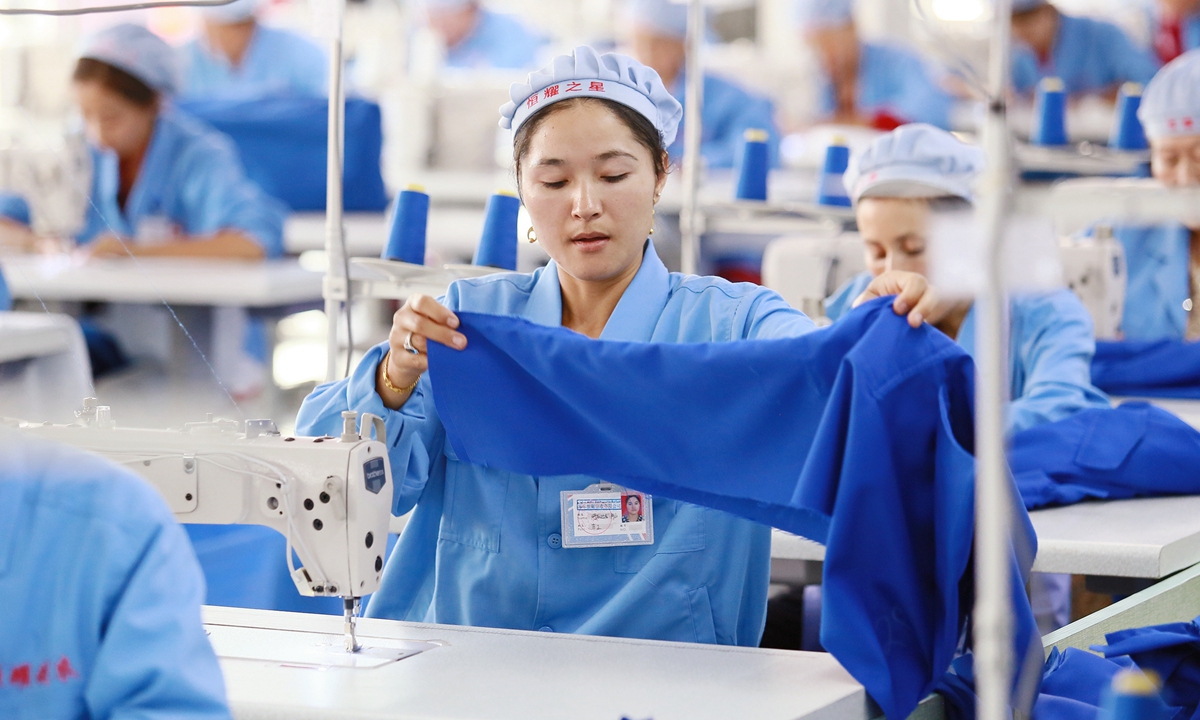Foreign
30,000 plus Xinjiang-related stories expose how certain Western media fabricate, hype up ‘forced labor’ smear

By Tuersun Aibai
In recent years, anti-China forces in the West have hyped up the so-called forced labor narrative, an accusation to systematically vilify China, as an attempt to tarnish the country’s image on the international stage, weaken its international reputation, and alienate the nation by jeopardizing its friendly and cooperative relations with other countries.
In order to understand the political and economic motives behind their “forced labor” fallacy, as well as the exploration of the narrative’s manipulation strategies, transmission paths, and methods of the fallacy, I conducted a statistical analysis of over 30,000 Xinjiang-related stories from 22 media outlets in 15 countries and regions.
From these, I selected 189 pieces published by 13 media outlets that spread the “forced labor” slander for further analysis and found out that the claim of “forced labor” concocted by anti-China forces in the West is a new discourse pattern and narrative framework, which has gradually evolved from the framework of early public opinion manipulation, into a comprehensive economic blockade and repression of Northwest China’s Xinjiang Uygur Autonomous Region.
How ‘forced labor’ smear grows
Based on the analysis of 189 stories published by 13 overseas media outlets, I found that the evolution process of the “forced labor” smear campaign can be divided into three phases.
The first phase is a “topic brewing period” that spanned from December 2018 to March 2020.
In December 2018, the Associated Press (AP) first claimed that a company in Xinjiang’s Hotan city had cooperated with local education and training program institutions to sell clothes made by the program’s trainees to the US. The story was later quoted by many overseas media outlets and caught the attention of the US government, which in turn required that certain clothing and outdoor recreation product brands such as Adidas inspect their industrial chains, and enforced a prohibition of the importation of so-called forced labor products.
On December 18 that year, Voice of America (VOA) published a story titled US Sportswear Traced to Factory in China’s Internment Camps, in which it alleged that Chinese government was “forcing some detainees to work in manufacturing and food industries.” Two days later, VOA published a second article titled US Reviews Report of Imports from Forced Labor in China Camp, quoting several infamous Xinjiang separatists as stating that there was “forced labor” at Xinjiang’s vocational education and training centers. Other mainstream US media sources such as The New York Times (NYT) also published similar stories with incendiary claims that month.
During that period, claims of “forced labor” were introduced by US media outlets as fodder for a new anti-China topic of focus, and its transmission scope was mainly within the US and its media sources. The claim only served to attack the trainees working at the clothing industry in the region after receiving vocational education.
The second phase of the West’s “forced labor” smear campaign, a “topic fomentation period,” spanned from March 2020 to December 2021.
On March 1, 2020, the Australian Strategic Policy Institute (ASPI), a think tank reliant on US defense funds and is keen to concoct and amplify various anti-China topics, released a “research report” titled Uygurs for sale ‘Re-education’, forced labor, and surveillance beyond Xinjiang. The ridiculous report attacked China’s efforts in accelerating Xinjiang’s development, and slandered the employment placements of trainees from Xinjiang’s vocational education and training program. Western media outlets later widely referenced and quoted the report.
By further fueling the “forced labor” narrative, some so-called “human rights groups” and media outlets called on governments in Western countries such as the US and the UK to investigate the industrial chains and asked local enterprises to cut ties with their Chinese counterparts that use Uygur labor.
In March 2020, Switzerland’s Better Cotton Initiative (BCI) proposed that some major clothing brands ban the use of Xinjiang-sourced cotton using the groundless “forced labor” accusations as a pretext, claiming that the production cotton in Xinjiang “violated labor rights,” and “violated human rights.” Following this call to action, certain US congressmen introduced the so-called “Uyghur Forced Labor Prevention Act (UFLPA),” which required companies to obtain certification from the US government that any product imported from Xinjiang into the US was not produced with the use of “forced labor.” The bill also required the US president to “identify and designate” visa or financial sanctions against any foreign person who “knowingly engages” in the “forced labor” in the Xinjiang region.
The “forced labor” fallacy continued to grow in the European Union (EU). In December 2020, the European Parliament passed a resolution on Xinjiang, falsely alleging the use of “forced labor” in the region. It required EU member countries to impose sanctions on Xinjiang officials and boycott so-called “forced labor” products from Xinjiang.
During this period, the scope of the “forced labor” smear campaign had further expanded, and some Western governments introduced related bills to “legally” base their “forced labor” accusations. The smear campaign targeted not only the employment of surplus rural labor in Xinjiang, but also extended to more industries in this region such as tomato cultivation in the agricultural sector and the photovoltaic and solar energy product manufacturing industries.
Legislatures, judiciaries, border defense, and the commerce departments of some Western countries banded together to form a community of mutual interests in this smear campaign. Western media sources, NGOs, think tanks, and enterprises also followed suit, cooperating closely with governments from the public opinion and “academic” standpoints.
The third phase, which started from January 2022 and is currently ongoing, is the “instrumentalization and politicization period.”
Sample analysis based on media coverage suggested that the focus of media outlets in most countries has shifted to the “force labor” fallacy, while the US and the UK conversely remain focused on actively hyping up the fallacy. Data showed that eight US- and UK-based media outlets published a total of 24 stories attacking Xinjiang between January and April in 2022.
In this phase, the “forced labor” smear campaign entered a new “practice stage,” serving the West’s goals of escalating the economic suppression of China by indiscriminately attacking all the products made in Xinjiang and all the enterprises in the region.
Worse still, with the Xinjiang-related “bills” coming into effect, anti-China forces in the West have completed the transition from public opinion attacks, to the introduction of legislative economic sanctions. Now the public opinion campaign has turned into an economic war waged against China. The “forced labor” fallacy has become an integral part of the Western anti-China forces’ strategic containment of China.
The graphic shows a four-step scheme of US’ malicious slander against China. From govt, think thanks to the media, US’ disinformation machines fabricate lies and pave the way for legislation that aims to contain China. Graphic: Feng Qingyin/GT
The graphic shows a four-step scheme of US’ malicious slander against China. From govt, think thanks to the media, US’ disinformation machines fabricate lies and pave the way for legislation that aims to contain China. Graphic: Feng Qingyin/GT
Tactics of public opinion manipulation
The “forced labor” fallacy did not emerge accidentally. Thanks to a long-term planned process and a clear manipulation strategy of public opinion by Western anti-China forces, who, prey on different countries’ perceptions of the human rights concept to create and hype up lies under the guise of “protecting human rights,” the fallacy gained momentum.
The concept of human rights is regarded as a value deeply influenced by the historical and cultural traditions of different countries. There are both commonalities and differences in the understanding of human rights among countries. Therefore, the UN’s Universal Declaration of Human Rights, as well as the European Declaration of Human Rights, do not specifically give a universal definition of the standards of human rights.
Since the founding of the People’s Republic of China, the Chinese government has regarded the rights to subsistence and development as fundamental human rights, fully protected the political, economic, social, and cultural rights of the people of all ethnic groups, and continuously promoted and elevated the development of human rights work in practice. China has written human rights protection into the country’s Constitution and the Constitution of the ruling Communist Party of China (CPC), and further promoted the systematization and legalization of human rights protection. China has also held human rights forums and issued a white paper to comprehensively elaborate its concept of human rights.
However, the anti-China forces in the West, who ignore the differences in human rights concepts between China and the West and China’s achievements in the protection and promotion of human rights, politicize, weaponize, and instrumentalize the concept of human rights by employing the “forced labor” fabrications and hype.
Some biased western media sources, by citing misleading quotes, wantonly attack the human rights situation in China, so as to promote the spread of the “forced labor” accusation by employing several tactics.
Tactic one: “Criminalize” Chinese government
The “forced labor” accusation falsely alleges that the purpose of the transfer of the employment policy in Xinjiang region is to “strip” Uygurs of their cultural identity and “assimilate” them. Western anti-China forces have further fabricated lies claiming that China committed so-called “crimes against humanity” and “crimes of genocide” in the region.
For instance, on March 2, 2020, an Australian Broadcasting Corporation (ABC) article quoted an ASPI researcher as saying that the goal of the labor transfers was “political,” with an aim toward the “stripping of their unique culture and identity.” On November 25, The Global and Mail cited some infamous anti-China “human rights groups” that “Uygurs and other Turkic minorities have been subject to forced labor as part of China’s plan to control the Uygur population in the region.” On August 23, 2021, the Washington Post quoted an anti-China group’s statement as saying that “no American corporation should be doing business in a region that is the focal point of a campaign of genocide targeting a religious and ethnic minority.”
The reality is that, the Uygur population has increased from 3.61 million in 1953 to 11.62 million in 2020, an increase of over three-fold, while the Chinese national population growth rate over the same period only grew two-fold. The growth rate of the Uygur population has been higher than the national average.
Tactic two: Demonizing China’s poverty alleviation policies
For instance, on June 24, the Washington Post groundlessly claimed that a Chinese company “recruits and employs Uygurs and other minorities via state labor programs that aim to place them in factories.” On March 7, CNN quoted a British scholar as saying that the job programs in Xinjiang “are often non-consensual, and people who refuse can be punished with internment.”
Contrary to the lies and rumors they fabricated, the fact is that workers of all ethnic groups in Xinjiang region, including those who were transferred for employment and those who had completed their studies in learning institutions and training centers, have the agency to choose their preferred jobs and regions of placement. They sign labor contracts and receive remuneration in accordance with the law, and enjoy various social insurance benefits.
The total number of rural migrant workers in China reached 30.7 million in 2021, of which 3.2 million were from Xinjiang. With an increase in the number of stable employment, the economic income of the people of all ethnic groups in Xinjiang has continued to increase, and the regional per capita gross domestic product (GDP) had increased from 45,476 yuan ($6,225.9) in 2017 to 53,593 yuan in 2020.
Tactic three: Stigmatizing assistance measures for transfer employment
The “forced labor” smear campaign claims that the Chinese government assigns staff to “monitor” Uygur employees, and even defames the existence of administrators of ethnic and religious affairs for Uygur employees at local companies, terming it as “monitoring.”
On April 27, 2021, The Guardian quoted a member of an Australian anti-China group as saying that Uygurs were “held in secure compounds, working extremely long hours and under constant surveillance, and with political indoctrination as part of their daily routine.” On March 9, 2020, a Washington Post article even ridiculously described the psychological counseling rooms as having been set for the purpose of thought policing Uygur employees.
Such psychological rooms, far from solely being found in Xinjiang, are part and parcel of many Chinese and foreign enterprises to help relieve psychological pressure experienced by employees. This is a common international practice. In November 2019, Chinese authorities issued the Specification of Healthy Enterprise Construction (trial), which requires employers to attach importance to their employees’ physical and mental health, and encourages enterprises to set up mental health counseling rooms.
Tactic four: Distorting service work for labor transfer employment
On March 2, 2020, ABC quoted an ASPI researcher and separatist as saying that Uygur workers “are often transported across China in special segregated trains,” and “authorities and factory bosses continue to closely monitor them.” On April 27, 2021, The Guardian claimed that Uygurs employees “have limited or no communications with their families; mothers have been separated from their babies and families have been torn apart,” citing the words of an anti-China separatist.
China fully protects the legitimate rights and interests of workers of all ethnic groups in law, policy, and practices, which advocate equal pay for equal work without discrimination against any ethnic groups. Chinese laws expressly stipulate that Uygur people enjoy the same rights as other ethnic groups, and Chinese enterprises have no right to and nor should they restrict their freedom.
Chinese citizens enjoy freedom of religious belief, and the state guarantees normal religious activities. Uygur employees participate in religious activities on the premise that they abide by China’s laws and regulations, the enterprise’s rules, and normal work routines.
Tactic five: Attacking China by citing misleading, tendentious claims
Based on my analysis of 189 stories from 13 media outlets, I found that when hyping up the “forced labor” smear, overseas anti-China media sources mainly cited “research report” published by the ASPI and anti-China scholar Laura Murphy, and the remarks of the separatist organization “World Uyghur Congress” along with its affiliated bodies.
A considerable number of their Xinjiang-related stories cited anti-China politicians and scholars to support their narratives, lack field research and first-hand information. The stories did not provide any reliable information, let alone contain actual interviews conducted with Uygur employees.
For example, in the article Canadian watchdog asked to probe allegations that imports made with forced labor in China published on April 11, 2022, The Globe and Mail quoted an “executive director” of a so-called “Uygur rights advocacy project” based in Ottawa as saying that he hopes a probe will drive Canada to take greater action against imports made using “forced labor.”
Obviously, some Western media outlets achieve their goals of misleading their audiences and spreading fallacies by unilaterally quoting false statements made by some anonymous and anti-China sources, and using sensational and biased headlines. Their stories and quotes, without investigating the actual situation on the ground in Xinjiang region, lack verifiability. The information they convey in their stories is full of malicious speculation and lies.
Western anti-China forces concocted the “forced labor” fallacy as a means to serve their goal of suppressing China’s economic development. To clarify the lies and show the world a real Xinjiang, China should make more efforts in several aspects, such as focusing on the international communication with the Arab world and developing countries, strengthen the public dissemination of accurate information, while also paying close attention to the slanderous tactics employed by anti-China forces to defame China.
(The auther is an expert from the School of Journalism and Communication at Xinjiang University)
Foreign
Expressway service station in Shandong achieves carbon neutrality

By Li Rui, People’s Daily
A man surnamed Lin, driving a new energy vehicle, was on his way from Jinan to his hometown Weifang, both in east China’s Shandong province. As the battery of his vehicle ran low, he pulled up in a service station along the Qingdao–Yinchuan Expressway.
Experience told him that a service station was a place where drivers and passengers could refuel vehicles, use the bathroom, grab a drink of water and have a meal. However, he found this service station a little bit different.
The Jinan East service station was a key carbon-zero station built by Shandong Hi-Speed Company Limited. It was put into operation on July 26, 2019. During China’s just-concluded National Day holiday, the service station received an average of 13,000 vehicles and 44,000 people on a daily basis.
“How long does it take for a vehicle to get 200 kilometers of range with this ultra-fast charging pole?” Lin asked a staff member of the service station.
“One second for one kilometer of range,” the staff member replied, pointing to an advertising board above that said “Get Fully Charged over a Cup of Coffee.”
Being skeptical about it, Lin scanned a QR code on the charging pole with his phone. Then, he unwound outside his car and went to get a cup of hot water. When he came back, he found his car fully charged.
The power level of the charging pole Lin used was 600 kW, and there were also charging poles of different models and power levels available for users to choose from at the service station.
The Jinan East service station covers an area of 300 mu, or 20 hectares. With so many charging poles in service, it consumes about 6,000 kWh of electricity each day. Where does such a huge load of electricity come from?
On the canopy, rows of solar panels were neatly paved. They were a part of a renewable energy utilization system – a 3.2 MW solar farm built on side slopes of the expressway, parking lot canopies and rooftops. The system also comes with a 3.2 MWh power storage facility.
At present, the service station generates an average of over 10,000 kWh of electricity on a daily basis, far exceeding its daily power consumption volume. This saves 1,200 tons of standard coal per year. The service station also transmits extra electricity to the power grid through safe and efficient means.
At noon, the fragrance of food was floating in the corridors of the crowded comprehensive building of the service station. As one of the busiest service stations in Shandong province, the Jinan East service station welcomes over 10 million passengers each year. How does it manage the wastewater generated by such a huge crowd?
In the “backyard” of the service station, there were two white bungalows at the corner of a tree lawn. Inside them, sewage treatment facilities were running, processing wastewater and pumping it back to the water tanks, which would be used for irrigation and floor washing.
The treatment system for waste and pollutant resources successfully addresses the challenges of the huge variation between water usage peaks and lows, as well as significant greenhouse gas emissions from sewage, effectively recycling and reusing treated water.
“In the past, diesel vehicles were used for service area operations and cleaning, but now they have been replaced with electric vehicles. The catering businesses have also undergone electrification upgrades for their gas stoves, replacing them with clean energy sources wherever possible,” a staff member said.
Carbon emissions are invisible and intangible. How are they measured?
Shandong Hi-Speed Company Limited has independently developed a smart energy management system, which builds a digital twin of the station and displays all relevant data on a screen, including daily electricity generation, charging station power, peak electricity generation periods, air conditioning usage and more.
It is learned that this zero-carbon smart energy management system collects data of all indirect carbon emission sources such as photovoltaics, energy storage, micro grids, lighting, HVAC (heating, ventilation, and air conditioning), and wastewater treatment. It can automatically calculate, make decisions, and intelligently control equipment.
For example, if the air conditioning is set at 26 degrees Celsius indoors, the system can automatically shut down some air conditioners when the temperature falls below this threshold, refining energy management and enabling intelligent equipment control.
According to real-time monitoring by the system, the service station emits an average of 2,060.97 tons of carbon dioxide per year. By planting over 19,000 square meters of greenery, the service station offsets greenhouse gas emissions.
Currently, the forestry area of the service station covers 67,000 square meters, or about 33 percent of the station’s total area. Through forestry carbon sequestration, the system helps reduce an annual average of 3,410.1 tons of carbon dioxide, with a forestry carbon sequestration volume of 53.4 tons of carbon dioxide, realizing “zero-carbon” operations. The service station now has the capability for sustainable carbon neutrality.
“So far, China has built nearly 4,000 pairs of expressway service stations. If we can promote zero-carbon experiences in more service stations, it would be of great significance,” said Zhou Pengfei, deputy director of the energy and environment department of Shandong Hi-Speed Company Limited.
Foreign
Qinling Mountains better safeguarded with comprehensive digital platform

By Zhang Tie, Zhang Danhua, People’s Daily
The Qinling Mountains in northwest China’s Shaanxi province are a natural boundary between China’s north and south in terms of geology, climate, biodiversity, water systems, and soil types.
The unique geographic environment creates abundant moisture, and the rugged terrain harbors rich plant and animal resources, earning the Qinling Mountains the nickname “China’s Central Park” and establishing them as a crucial ecological barrier for the country.
In recent years, ecological protection and restoration of the Qinling Mountains has maintained a priority of Shaanxi province.
“There appears to be waste dumping in the east of Liyuanpo village in Shijing neighborhood,” an alert popped up on the screen of a digital comprehensive monitoring platform for the Qinling Mountains of Huyi district of Xi’an, capital of Shaanxi Province.
Staff member Zhao Na immediately contacted Mao Juan, a local grid officer: “Drones have captured footage, and AI analysis has detected unauthorized dumping.”
In less than an hour, Mao arrived at Liyuanpo village. Upon investigation, she learned that a villager had been renovating his house and had dumped construction waste by the roadside.
She promptly took photos for evidence, uploaded them from her phone, and informed the neighborhood office. After the area was cleared by the following morning, Mao revisited the site, verified the cleanup, and uploaded the update to the platform.
The ecological protection area of the Qinling Mountains covers six districts and counties in Xi’an, accounting for about 55 percent of the city’s total area. The rapid handling of issues like this is a result of an integrated ecological monitoring and protection system for the Qinling Mountains.
The system includes satellites that provide periodic remote sensing images, drones that conduct routine patrol flights, cameras offering real-time monitoring, and 1,240 dedicated grid officers carrying out inspections.
“With this system, countless ‘eyes’ help us protect every ridge and valley of the Qinling Mountains,” said Lei Bo, director of the technology and grid management department of the Xi’an municipal bureau of Qinling ecological environment protection.
From January to August this year, the platform autonomously identified and processed 2,480 cases involving unauthorized construction and dumping. Most cases were resolved within one to three days.
In recent years, Xi’an has continuously improved the systems and mechanisms for regular and long-term protection of the Qinling Mountains. The approach combines human surveillance with technology-based monitoring, and grid-based management with networked coordination, making protection efforts more targeted and intelligent.
Now, the entire landscape can be visualized on a single map, which shows forests, rivers, buildings, and mineral distributions, creates a digital model of the Qinling Mountains.
Each village has its own grid, with at least one grid officer, which forms a four-tiered management system from the municipal level down to villages.
Municipal- and district-level platforms, as well as several industry-specific platforms have been integrated, enabling information sharing and seamless data exchange to form a unified digital supervision system for the Qinling Mountains.
“We can detect even the smallest fire, down to a single lighter, thanks to the integration of thermal, smoke, and light sensors,” said Hua Yiping, director of the Qinling ecological protection and comprehensive law enforcement bureau of Huyi district. The digital monitoring platform now extends to multiple applications, including forest fire prevention, flood control, water quality monitoring, and geological disaster monitoring.
Currently, the populations of wild plants and animals in the Qinling Mountains are steadily increasing, with 99.3 percent of the Qinling area within Shaanxi province now rated as having an excellent ecological environment.
“In the future, we will continue to enhance the automation, intelligence, and precision of Qinling’s protection measures. We aim to refine our monitoring systems and ensure thorough, dynamic inspections and remediation,” said Li Bo, deputy director of the Xi’an municipal bureau of Qinling ecological environment protection.
Foreign
SWChina’s Guizhou builds itself into computing power base serving whole country

By Chen Junyi
At the Gui’an Supercomputing Center, which is located in Guiyang, southwest China’s Guizhou province, over 600 servers are running at full speed, supplying constant computing power to cities like Shenzhen, Guangzhou, and Wuhan, creating a vibrant ambiance with constant hum of cooling fans and flickering indicator lights.
As one of the eight major hubs of China’s national integrated computing power network, Guizhou is actively pursuing the integrated development of data storage and computing, with a particular focus on intelligent computing.
It aims to enhance the capacity in computing power supply, effectively match the supply and demand of computing power within the province and elsewhere, and better utilize computing power and localize the computing industry, so as to establish a support base serving the whole country.
Guizhou launched its plans to develop data centers ten years ago. It boasts numerous natural advantages for developing the computing industry, such as safe geological conditions, reliable power supply, and low average temperatures. China’s three telecommunication operators, namely China Telecom, China Mobile, and China Unicom, have all set up data centers here, making it the first province in China to host data centers of all the three.
After a decade of development, Guizhou is currently home to 47 data centers, either under construction or in operation, including 25 super-large and large data centers, most of which are located in the Gui’an New Area.
The Gui’an New Area is known for its flat terrain and an annual average temperature of 15 degrees Celsius. The region enjoys 99.5 percent of days with good air quality throughout the year, thereby serving as a natural air conditioner and oxygen bar.
The power usage effectiveness (PUE)of data centers in the region, a metric for energy efficiency, is lower than 1.2, which is at the forefront of all green data centers across the country. It is also one of the areas in China where data centers boast the lowest energy consumption and the longest equipment lifespan.
“As the carrier of computing power, data centers are equipped to support high-performance application scenarios by leveraging advanced computational capabilities and large-scale data processing power through the use of various hardware components such as servers and graphics cards,” said Peng Benqian, head of the Gui’an Supercomputing Center and director of the technology research and development department of Gui’an New Area Science and Technology Innovation Industries Development Co., Ltd., the company that runs the center.
In the past, most data centers in Guizhou were primarily focused on storage. With the rapid development of artificial intelligence (AI), Guizhou is advancing intelligent computing, which forms the basis of AI development. The data centers are rapidly transforming from mere “storage centers” to integrated “storage and computing ones.”
The Gui’an Supercomputing Center, the first of its kind in Guizhou, was put into operation at the end of 2020. “We have more than 600 servers, and the peak computing power has reached 130 petaflops,” Peng said.
“It would take nearly 600 years to create special effects rendering for a 3D animated film with a regular computer. However, the whole process can be completed within 3 months at our center,” he said.
In addition to locally built computing power centers, top internet companies such as Huawei, Tencent, and NetEase have established superlarge computing centers and intelligent computing centers in Guizhou. Besides, many banks have set up their financial data centers in the province.
Guizhou has become one of the regions in China with the strongest intelligent computing capabilities. By the end of July 2024, its computing power had reached 40.55 Eflops (a measurement unit used to determine a computer’s speed), with intelligent computing power amounting to 37.578 Eflops, accounting for over 90 percent.
Just like other commodities, computing power cannot be on a perfect supply-demand balance. Idle computing resources will enter a public computing resource pool and be scheduled by the Guizhou branch of China’s national integrated computing power network to efficiently connect the resource side and the demand side.
The transmission and trading of computing power rely on network infrastructure. Guizhou has established direct connections with 38 cities across China, including Beijing, Shanghai, Shenzhen, and Guangzhou.The computing power can meet the huge demand of the “East data, west computing”project, a key part of China’s digital infrastructure which aims to coordinate the computing capabilities of the country’s eastern regions, where the need for computing is high, with inland western regions like Guizhou, where abundant renewable resources are optimal for building data centers, according to Zhang Jie, head of the business department of Gui’an New Area Data Service Technology Co., Ltd.
Meanwhile, Guizhou is leveraging its computing power to drive industrial development and extend the industrial chain. With the support of computing power, many local companies have begun to explore new opportunities.
Guizhou Tuzhi Information Technology Co., Ltd. is a technology company specializing in geospatial big data application and development and a professional provider of real-time spatial-temporal information services integrating air, space, and ground data. With over 8 years of experience, the company has witnessed the evolution of Guizhou’s big data industry.
“The ecosystem of the big data industry in Guizhou is getting better and better, with refined computing power support, industry applications and data transactions. We have seen increasing productivity and expanding business scope,” Huang said.
-

 Politics13 hours ago
Politics13 hours agoGuber Poll: Forum Backs Hon. Umeoji As Anambra’s Best Option
-

 Politics19 hours ago
Politics19 hours agoPresidency Assures: No Leadership Void as Tinubu, Shettima Remain Engaged Abroad
-

 Business19 hours ago
Business19 hours agoFuel Price Hike: FG Maintains Routine Engagement with Organised Labour
-

 Politics18 hours ago
Politics18 hours ago“Give Tinubu 40 Years, He Won’t Go Anywhere” – Adebayo
-

 News18 hours ago
News18 hours agoJos DisCo to Launch Feeders Management System and Bilateral Arrangements
-

 News18 hours ago
News18 hours agoBorno: Governor Zulum Praises NCAA DG Najomo for Enhancing Aviation Safety
-

 News14 hours ago
News14 hours agoBOWFT: Edo First Lady, Obaseki, Rallies Wives of Governors to Address Teenage Pregnancy and Abortion
-

 Entertainment18 hours ago
Entertainment18 hours ago“No Breathing Space” – Temi Otedola Takes Center Stage with Stunning New Photos







